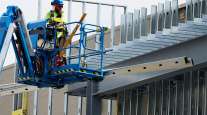Economic Growth Cools as US Companies Rein in Inventories

The U.S. economy expanded at a slower pace in the third quarter as companies took advantage of gains in consumer and business spending to reduce bloated stockpiles.
Gross domestic product grew at a 1.5% annual rate, in line with the 1.6% median forecast of economists surveyed by Bloomberg News, Commerce Department data showed Oct. 29. Excluding the biggest swing in inventories in four years, the pace of growth was 3% compared with 3.9% in the previous three months.
Household purchases, buoyed by job and income gains, probably will continue to underpin the world’s largest economy even as weaker demand from overseas customers holds back exports and manufacturing. The quick rebalancing of stockpiles to be more in line with domestic demand heading into the holiday season indicates factory production soon will stabilize, eliminating a source of weakness.
“The headline is not indicative of how solidly the U.S. is growing,” said Gennadiy Goldberg, U.S. rates strategist in New York with TD Securities, who correctly projected the third-quarter gain. “The domestic drivers in consumption are quite strong.”
The median forecast for GDP, the value of all goods and services produced, was based on a survey of 80 economists. Projections ranged from gains of 0.9% to 2.4%. The estimate is the first of three for the quarter. The other releases scheduled for November and December, when more information becomes available.
The economy grew at an average 2.3% pace in the first half of the year as a 3.9% surge in the second quarter more than made up for a first-quarter slowdown caused by frigid weather, a labor dispute at West Coast ports and cutbacks in the energy industry. GDP expanded 2.4% in all of 2014.
A separate report from the Labor Department showed the number of applications for unemployment benefits were little changed last week, hovering near the lowest levels in four decades. Jobless claims rose by 1,000 to 260,000 in the period ended Oct. 24.
The Commerce Department’s third-quarter growth estimate showed household purchases, which account for almost 70% of the economy, rose at a 3.2% annual pace compared with a 3.6% pace in the prior three-month period. Personal consumption added 2.2 percentage points to growth.
After-tax incomes adjusted for inflation climbed at a 3.5% annual rate, almost three times the 1.2% gain in the prior three months. That allowed the saving rate to increase to 4.7% from 4.6%, indicating consumers have plenty of firepower to continue to drive growth.
Stable job growth in 2015 and cheaper prices at the pump have helped cushion Americans’ pocketbooks, supporting the household spending that makes up the biggest share of U.S. growth. While payrolls advanced at a slower pace than forecast in August and September, the pace of hiring this year has averaged 198,000 a month, beating the annual average for seven of the 10 years through 2014.
Gasoline costs have been receding for the past two months. The average price of a gallon of regular gasoline fell to $2.20 on Oct. 27, the lowest since February, according to auto group AAA. That compares with a daily average of $3.34 in 2014.
A smaller gain in inventories subtracted 1.4 percentage points from growth, the biggest drag since the last three months of 2012, the Commerce Department’s report showed. The $59.8 billion slowdown at an annual pace from the prior quarter was the biggest since the third quarter of 2011.
“The story on inventories is that it’s a big adjustment that occurred quickly and should be far less of a drag” in the next few quarters, Stuart Hoffman, chief economist at PNC Financial Services Group Inc. in Pittsburgh, said before the report.
Outside of inventories, business investment held up last quarter. Spending on new equipment climbed at a 5.3% annualized rated, the most in a year. However, outlays on intellectual property such as software and research and development cooled, growing 1.8%, the smallest gain in two years.
The trade deficit was little changed, while government spending advanced as gains in federal non-defense and state and local outlays made up for a drop in military procurement.
Federal Reserve policymakers said at the close of their two-day meeting in Washington on Oct. 28 that they will consider tightening policy at their next meeting in December, without making a commitment to act this year as the economy continues to expand at a “moderate” pace.
The officials removed a line from September’s meeting statement about global economic and financial developments restraining economic activity and added a reference to the possibility of increasing the rate at the “next meeting” based on “realized and expected” progress in reaching their employment and inflation goals.




